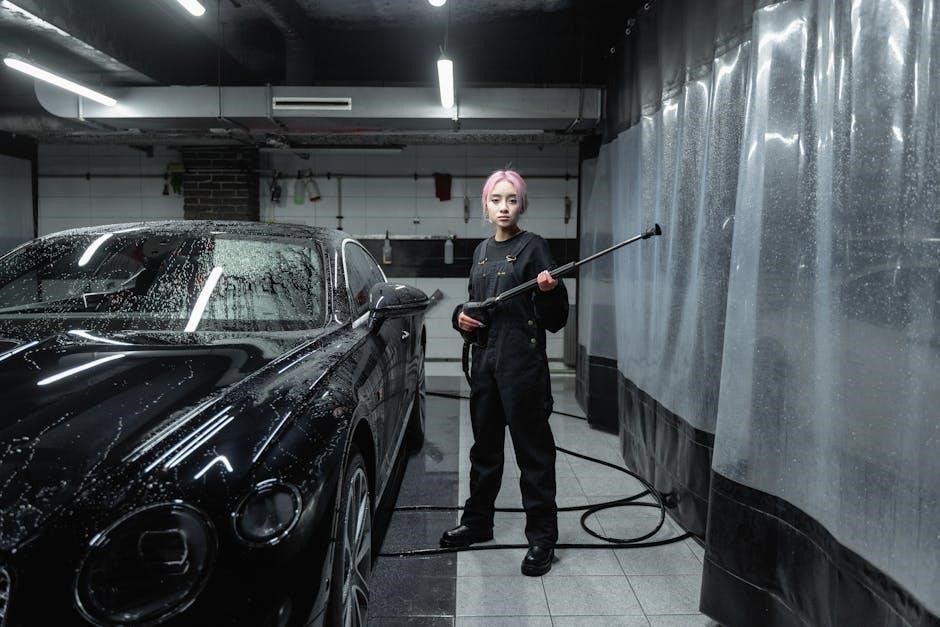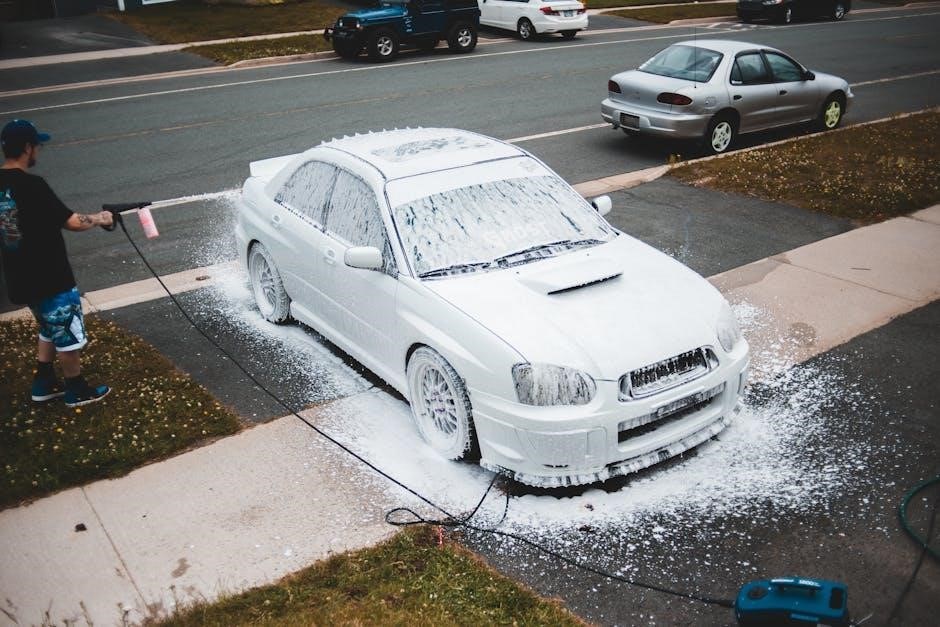Welcome to the Ryobi Pressure Washer Manual, your comprehensive guide to understanding and optimizing your pressure washer’s performance. This manual provides essential information for safe operation, maintenance, and troubleshooting, ensuring you get the most out of your cleaning tasks. Designed for domestic use, Ryobi pressure washers offer powerful cleaning solutions for decks, driveways, and more. Always read the manual carefully before use to ensure proper assembly and operation.
Overview of the Ryobi Pressure Washer
The Ryobi pressure washer is a versatile cleaning tool designed for domestic use, ideal for cleaning decks, driveways, windows, and more. Available in various models, including gas-powered options like the 3300 PSI, it offers powerful cleaning solutions. Known for its portability and ease of use, Ryobi pressure washers are perfect for tackling outdoor cleaning tasks efficiently. With models ranging from 1600 to 3000 PSI, they provide adaptability for different cleaning needs, ensuring effective results for homeowners seeking reliable performance.
Importance of Reading the Manual
Reading the Ryobi pressure washer manual is essential for safe and effective operation. It provides critical safety precautions, assembly instructions, and maintenance tips. Understanding the manual ensures proper usage, helping you avoid accidents and prolong the product’s lifespan. It also guides troubleshooting and optimizing performance. By following the manual, you can maximize efficiency and adapt to different cleaning tasks. Always prioritize reading the manual before use to ensure a safe and successful experience with your Ryobi pressure washer.

Key Features and Specifications
Ryobi pressure washers deliver powerful cleaning with PSI ratings up to 3300, lightweight designs for portability, and compatibility with various nozzles and detergents for enhanced versatility.
PSI Ratings and Performance
Ryobi pressure washers deliver impressive cleaning power with PSI ratings ranging from 1600 to 3300, catering to various tasks. Higher PSI models, like the 3300 PSI gas-powered version, excel at heavy-duty cleaning, such as driveways and decks. Lower PSI options, like the 1600 PSI model, are ideal for lighter tasks, ensuring efficient performance without unnecessary force. This versatility allows users to tackle multiple cleaning projects effectively and efficiently, making Ryobi pressure washers a reliable choice for home and garden maintenance.
Design and Portability
Ryobi pressure washers are designed with portability in mind, featuring compact and lightweight constructions for easy mobility. Many models include wheels and ergonomic handles, making them simple to maneuver around gardens or yards. The durable design ensures long-lasting performance while remaining user-friendly. Whether stored in a shed or moved across uneven terrain, Ryobi pressure washers are built to be convenient and accessible, ensuring efficient cleaning without compromising on portability or durability.
Compatibility with Accessories
Ryobi pressure washers are designed to work seamlessly with a variety of accessories, enhancing their versatility. From different nozzle tips to detergent tanks, these attachments allow for tailored cleaning solutions. The manual highlights compatible parts, ensuring optimal performance. Accessories like bolts, U-shaped nuts, and quick-connect couplers are readily available, making it easy to customize your pressure washer for specific tasks. This compatibility ensures your Ryobi pressure washer remains efficient and adaptable for any cleaning job, whether it’s for domestic or professional use.

Safety Precautions
Always read the manual before use, ensure proper footing, and supervise children. Follow maintenance instructions to prevent hazards and ensure safe operation of your Ryobi pressure washer.
General Safety Guidelines
Always read the manual thoroughly before operation. Wear protective eyewear and ensure proper footing to maintain balance. Keep children supervised and away from the unit. Never use the pressure washer near open flames or sparks. Avoid using ladders or operating in wet conditions. Regularly inspect hoses and connections for damage. Follow all local regulations and manufacturer guidelines. Properly ground the unit to prevent electrical hazards. Store the pressure washer in a dry, secure location when not in use. Follow maintenance instructions to ensure safe and reliable performance.
Proper Usage and Handling
Connect the garden hose securely to ensure a steady water supply. Use the appropriate nozzle for each cleaning task to achieve optimal results. Apply detergent as recommended to avoid damaging surfaces. Adjust the pressure settings based on the surface being cleaned to prevent damage. Maintain proper balance and footing during operation. Regularly inspect hoses and connections for wear or damage. Store the pressure washer in a dry, secure location when not in use to maintain its performance and longevity.
Warning Labels and Symbols
Warning labels and symbols on your Ryobi pressure washer are crucial for safe operation. They indicate potential hazards, such as high-pressure jets or hot surfaces. Always read and follow these warnings to prevent accidents. Symbols may include alerts for proper grounding, electrical safety, and usage precautions. Heed all cautions to ensure safe handling and avoid damage to the unit or injury to yourself and others. Familiarize yourself with these labels before use to operate the pressure washer responsibly and effectively.

Assembly and Installation
Assembly and installation of your Ryobi pressure washer involve unpacking, inventorying parts, and connecting components like the garden hose. Follow step-by-step instructions for proper setup.
Unpacking and Inventory
Start by carefully unpacking your Ryobi pressure washer and inspecting all components for damage. Check for the power washer unit, high-pressure hose, spray wand, nozzles, detergent tank, and any additional accessories. Compare the items with the parts list in the manual to ensure nothing is missing. If any parts are damaged or missing, contact Ryobi customer support immediately. Proper inventory ensures smooth assembly and prevents delays in getting started with your cleaning tasks.
Step-by-Step Assembly Instructions
Begin by attaching the handle to the main unit securely. Next, connect the high-pressure hose to both the pressure washer and spray wand, ensuring tight connections. Attach the desired nozzle to the wand, selecting the appropriate size for your task. Refer to the manual for nozzle recommendations. Finally, connect the garden hose to the water inlet, ensuring it is properly secured. Double-check all connections before starting the unit to ensure safe and effective operation.
Connecting to a Garden Hose
Attach the garden hose to the pressure washer’s water inlet. Ensure the connection is secure to prevent leaks. Use a compatible hose with adequate water flow. Tighten the hose fitting firmly by hand or with a wrench if necessary. Turn on the water supply slowly to test for leaks. Proper connection is essential for optimal pressure washer performance and to avoid damage. Always follow the manufacturer’s guidelines for hose compatibility and installation.

Operating Instructions
Start the pressure washer by ensuring the hose is connected and the water supply is on. Use detergent as directed for enhanced cleaning. Adjust pressure settings based on the surface being cleaned. Always follow the manufacturer’s guidelines for operation to ensure safety and effectiveness. Proper usage ensures optimal performance and longevity of your Ryobi pressure washer. Refer to the manual for detailed step-by-step instructions.
Starting the Pressure Washer
To start your Ryobi pressure washer, ensure the water supply is connected and turned on. If using a gas model, check the fuel level and ensure the choke is in the correct position. For electric models, plug in the unit and ensure the outlet is working. Prime the pump by squeezing the spray gun trigger several times to allow water to flow. Start the engine or turn on the power, and let it run for a minute to warm up. Always ensure all connections are secure and wear safety gear like eye protection before beginning your cleaning task.
Using Detergent and Cleaning Solutions
For effective cleaning, use Ryobi-approved detergents or cleaning solutions specifically designed for pressure washers. Always refer to the manual for compatible options. Before adding detergent, ensure the pressure washer is set to the correct nozzle and pressure setting. Fill the detergent tank according to the manufacturer’s instructions, avoiding overfilling. Never use bleach or homemade solutions, as they may damage the machine or harm surfaces. Start with a low pressure setting to test the solution’s effectiveness before increasing power. This ensures safe and efficient cleaning for various surfaces.
Adjusting Pressure Settings
Adjusting the pressure settings on your Ryobi pressure washer ensures optimal cleaning for various surfaces. Use the pressure knob to increase or decrease the PSI, depending on the task. For delicate surfaces, select a lower PSI setting, while tougher stains may require higher pressure. Always use the correct nozzle for the selected pressure to maintain efficiency and avoid damage. Refer to the manual for specific PSI recommendations and guidelines for different cleaning tasks to achieve the best results safely and effectively.
Maintenance and Care
Regular cleaning and inspection of your Ryobi pressure washer are essential for optimal performance. Store it in a dry, protected area to prevent damage and extend its lifespan.
Regular Cleaning and Inspection
Regular cleaning and inspection of your Ryobi pressure washer are crucial for maintaining its performance and longevity. Always check for wear and tear on hoses, nozzles, and seals. Clean the filter regularly to ensure proper water flow and prevent blockages. Inspect the pump and motor for any signs of damage or leakage. Store the unit in a dry, protected area after use to avoid rust or corrosion. Follow the manual’s guidelines for routine maintenance to keep your pressure washer operating efficiently and safely.
Storing the Pressure Washer
Proper storage of your Ryobi pressure washer is essential to maintain its functionality and longevity. Store the unit in a dry, well-ventilated area protected from extreme temperatures and moisture. Before storing, drain all water from the hoses and pump to prevent freezing or corrosion. Ensure all connections are secure and inspect for any damage. Follow the manual’s guidelines for storage to ensure your pressure washer remains in optimal condition for future use.
Troubleshooting Common Issues
If your Ryobi pressure washer isn’t performing as expected, check for common issues like low water pressure, clogged nozzles, or faulty connections. Ensure the pump is primed and all hoses are securely attached. If the unit won’t start, verify the power source and fuel levels. For leaks, inspect hoses and connections for damage. Refer to the manual for detailed solutions or contact Ryobi customer support for assistance. Regular maintenance can often prevent these issues from arising.

Tips for Effective Cleaning
Choose the right nozzle for the job, adjust pressure settings for different surfaces, and use detergent for tough stains to achieve optimal cleaning results efficiently.
Choosing the Right Nozzle
Selecting the appropriate nozzle is crucial for effective cleaning. The wide fan nozzle is ideal for large surfaces like driveways, while the narrow nozzle is better for tight spaces. Use the detergent nozzle for tough stains and the low-pressure nozzle for delicate surfaces. Always match the nozzle to the task to ensure efficient cleaning and prevent damage to surfaces. Refer to your Ryobi manual for guidance on nozzle types and their recommended applications.
Cleaning Different Surfaces
When cleaning various surfaces, adjust your technique to suit the material. For wood decks, use a wide fan nozzle at low pressure to avoid splintering. Concrete driveways can withstand higher pressure, while windows require a low-pressure setting to prevent shattering. Always test a small area first to ensure the pressure won’t damage the surface. Use the appropriate nozzle for each task to achieve optimal results and maintain surface integrity.
Optimizing Water Pressure
Optimizing water pressure ensures efficient cleaning while protecting surfaces. Use the correct nozzle size and adjust the pressure dial according to the task. For delicate surfaces, lower the PSI; for tough stains, increase it. Maintain a steady flow by keeping the hose free of kinks and blockages. Regularly check the pressure washer’s settings to avoid over- or under-cleaning. Proper water pressure adjustment enhances cleaning effectiveness and prolongs the life of your Ryobi pressure washer.

Parts and Accessories
Your Ryobi pressure washer comes with essential parts like nozzles, hoses, and spray guns. Accessories include detergent tanks, brushes, and extension wands, enhancing versatility for various cleaning tasks.
Identifying Key Components
Your Ryobi pressure washer features essential components like the pump, motor, hose, spray gun, and nozzles. The pump generates high pressure, while the motor powers it. The hose connects to the spray gun, which includes interchangeable nozzles for different cleaning tasks. Additional components may include detergent tanks for cleaning solutions and brushes for tough surfaces. Familiarizing yourself with these parts ensures proper assembly and operation, maximizing efficiency and safety during use.
Replacing Worn or Damaged Parts
Regularly inspect your Ryobi pressure washer for worn or damaged parts to ensure optimal performance and safety. Common components that may need replacement include hoses, nozzles, and seals. Always turn off and unplug the unit before attempting any repairs. Refer to the parts diagram in your manual to identify specific components. Genuine Ryobi replacement parts are recommended for compatibility and durability. For complex replacements, consult the troubleshooting section or contact Ryobi customer support for assistance. Proper maintenance extends the lifespan of your pressure washer and ensures efficient cleaning results.
Recommended Accessories
To enhance your cleaning experience, consider genuine Ryobi accessories designed for compatibility and performance. Essential items include high-pressure hoses, various nozzle tips for different surfaces, and detergent tanks for efficient cleaning solutions. Extension wands and brush attachments are ideal for reaching tall areas or delicate surfaces. Always use Ryobi-approved parts to maintain warranty validity and ensure safety. These accessories can be found in the official Ryobi parts catalog or through authorized dealers. They help optimize your pressure washer’s functionality and versatility for various tasks.

Environmental Considerations
Using your Ryobi pressure washer responsibly promotes eco-friendly cleaning. Opt for biodegradable detergents and conserve water by adjusting pressure settings. Regular maintenance ensures efficiency, reducing waste and energy consumption.
Eco-Friendly Cleaning Practices
Adopt eco-friendly cleaning practices with your Ryobi pressure washer by using biodegradable detergents and minimizing water usage. Adjust pressure settings to avoid excess water consumption. Regular maintenance ensures optimal efficiency, reducing energy waste. Proper storage and handling of cleaning solutions prevent environmental contamination. Always follow local regulations for water and chemical disposal. By adopting these practices, you contribute to a sustainable cleaning routine while maintaining effectiveness. Simple adjustments can make a significant difference in reducing your environmental impact.
Water Conservation Tips
Conserving water while using your Ryobi pressure washer is essential. Always use the lowest pressure setting necessary for the task; Opt for low-flow nozzles to reduce water usage without compromising cleaning effectiveness. Turn off the washer when not in use to avoid unnecessary water flow. Regularly inspect hoses and connections for leaks to prevent waste. By adopting these practices, you can efficiently clean while minimizing water consumption and promoting sustainability. Proper maintenance also ensures optimal water usage over time.

Frequently Asked Questions
This section addresses common user queries about the Ryobi pressure washer, including troubleshooting, maintenance, and optimal usage. Refer to the manual or contact customer support for detailed solutions.
Common User Queries
Users often inquire about troubleshooting common issues, such as low water pressure or malfunctioning components. Many ask about proper detergent usage and compatibility with accessories. Others seek guidance on assembly steps or error codes. The manual addresses these queries, providing clear instructions for resolving operational problems and ensuring optimal performance. It also covers maintenance tips to prevent issues and extend the lifespan of the pressure washer. Refer to the troubleshooting section for detailed solutions.
Solving Operational Problems
The manual provides detailed solutions for common operational issues, such as low water pressure or faulty components. Users can find step-by-step troubleshooting guides to diagnose and resolve problems. It also addresses error codes and offers maintenance tips to prevent future issues. For persistent problems, the manual advises consulting Ryobi customer support or authorized service centers. Always refer to the troubleshooting section for clear, actionable solutions to ensure your pressure washer operates efficiently and effectively.

Warranty and Customer Support
Your Ryobi pressure washer is backed by a comprehensive warranty, ensuring coverage for parts and labor. For inquiries or issues, contact Ryobi customer service directly for assistance and support.
Understanding the Warranty
Your Ryobi pressure washer is protected by a comprehensive warranty that covers defects in materials and workmanship. The warranty period typically ranges from 3 to 5 years, depending on the model and usage conditions. It’s essential to review the warranty terms to understand what is covered and any exclusions. Proper registration and adherence to maintenance guidelines can ensure your warranty remains valid. Always keep your proof of purchase for warranty claims.
Contacting Ryobi Customer Service
For any inquiries or concerns regarding your Ryobi pressure washer, you can contact Ryobi customer service through their official website or by phone. Their team is available to assist with troubleshooting, warranty claims, and general support. Ensure you have your model number and purchase details ready for efficient service. Visit the Ryobi website for contact information, or use the support resources provided in your manual for guidance.
Additional Resources
Access online manuals, guides, and video tutorials for detailed instructions and troubleshooting tips on using your Ryobi pressure washer effectively. Visit the official Ryobi website for resources.
Online Manuals and Guides
Access official Ryobi pressure washer manuals and guides online for detailed instructions, troubleshooting, and part diagrams. Visit the Ryobi website or platforms like ManualsLib for free PDF downloads. Models such as RY80030, RPW170-G, and RPW3600 are available. These resources provide step-by-step assembly, operation, and maintenance tips. Additionally, video tutorials on YouTube and Ryobi’s official channel offer visual demonstrations for optimal use. These materials ensure you maximize your pressure washer’s efficiency and safety, addressing common queries and operational issues effectively.
Video Tutorials and Demonstrations
Enhance your understanding of the Ryobi pressure washer with official video tutorials and demonstrations. Available on Ryobi’s website, YouTube, and other platforms, these videos provide visual guidance for assembly, operation, and troubleshooting. They cover topics like starting the washer, using detergent, and adjusting pressure settings. Additionally, demonstrations showcase cleaning techniques for various surfaces, helping you achieve optimal results. These resources are ideal for visual learners and complement the manual, ensuring you make the most of your pressure washer’s features and capabilities effectively.